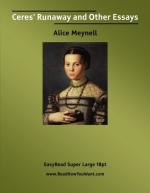THE PLAID
It is disconcerting to hear of the plaid in India. Our dyes, we know, they use in the silk mills of Bombay, with the deplorable result that their old clothes are dull and unintentionally falsified with infelicitous decay. The Hindus are a washing people; and the sun and water that do but dim, soften, and warm the native vegetable dyes to the last, do but burlesque the aniline. Magenta is bad enough when it is itself; but the worst of magenta is that it spoils but poorly. No bad modern forms and no bad modern colours spoil well. And spoiling is an important process. It is a test—one of the ironical tests that come too late with their proofs. London portico-houses will make some such ruins as do chemical dyes, which undergo no use but derides them, no accidents but caricature them. This is an old enough grievance. But the plaid!
The plaid is the Scotchman’s contribution to the decorative art of the world. Scotland has no other indigenous decoration. In his most admirable lecture on “The Two Paths,” Ruskin acknowledged, with a passing misgiving, that his Highlanders had little art. And the misgiving was but passing, because he considered how fatally wrong was the art of India—“it never represents a natural fact. It forms its compositions out of meaningless fragments of colour and flowings of line . . . It will not draw a man, but an eight-armed monster; it will not draw a flower, but only a spiral or a zig-zag.” Because of this aversion from Nature the Hindu and his art tended to evil, we read. But of the Scot we are told, “You will find upon reflection that all the highest points of the Scottish character are connected with impressions derived straight from the natural scenery of their country.”
What, then, about the plaid? Where is the natural fact there? If the Indian, by practising a non-natural art of spirals and zig-zags, cuts himself off “from all possible sources of healthy knowledge or natural delight,” to what did the good and healthy Highlander condemn himself by practising the art of the plaid? A spiral may be found in the vine, and a zig-zag in the lightning, but where in nature is the plaid to be found? There is surely no curve or curl that can be drawn by a designing hand but is a play upon some infinitely various natural fact. The smoke of the cigarette, more sensitive in motion than breath or blood, has its waves so multitudinously inflected and reinflected, with such flights and such delays, it flows and bends upon currents of so subtle influence and impulse as to include the most active, impetuous, and lingering curls ever drawn by the finest Oriental hand—and that is not a Hindu hand, nor any hand of Aryan race. The Japanese has captured the curve of the section of a sea-wave—its flow, relaxation, and fall; but this is a single movement, whereas the line of cigarette-smoke in a still room fluctuates in twenty delicate directions. No, it is impossible to accept the saying that the poor spiral or scroll of a human design is anything but a participation in the innumerable curves and curls of nature.




